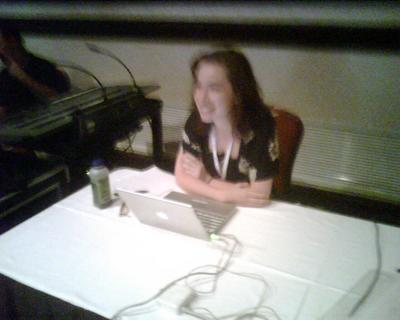June 21, 2007
Thanks for Playing
by Douglas McLennanDuring Thursday's three-hour session in Nashville we served more than 10,000 pages, with 3,500 visitors to the blog. Readers from all over the world contributed comments and our crack team of Orchestra League fellows were swamped monitoring the comments. We were so backlogged by late in the session that our server began returning error messages to those in the room who were trying to submit. We had to limit the number of photos we posted live because we were overwhelmed with all the pictures.
Some of those pictures are posted here. I can immediately see ways we could make this better for those following on the web (audio and video are the obvious adds). And there are ways we could enrich the experience in the room, too. But overall, I'd say it was a great experiment in offering multiple layers that people could delve into. The level of comments from the audience was terrific - very thoughtful. We learned a lot. I'll leave the comments section open for a week or so for anyone who wants to follow up on the blog.
Lastly - I want to commend the ASOL for trying this. It was a big risk with no obvious model, and it could have been a big bust. But Jesse Rosen and his staff are serious about exploring new ways of interacting with audiences. If you're going to have a meeting about changing relationships with art, what better way to demonstrate it that trying something new and unconventional with your own audience?
Thanks to all the bloggers and hundreds of commenters. Thanks also to the Orchestra Fellows - Kareem George, Katie Wyatt, Lisa Bryington, Lisa Bryington, Michael Manley, and Stephanie Trautwein - for facilitating the comments flow during the live session. And the intrepid Molly Sheridan, who blogged the session while it was going on. Anastasia Boudanoque is a force of nature, figuring out logistics and keeping the trains running. Julia Kirchhausen is a collaborator in the best sense of the word. And I warn anyone who has the fortune to work with Sandra Mandel and Katherine Klenn that you better go into training to keep up with them. The tech volunteers from Vanderbilt were unflappable and professional in the best senee of the word. And the Renaissance Hotel tech team made a complicated setup look easy. Lastly, Jesse was a great partner - insisting on sensible answers to frame was was going to happen, yet making enough room to think about the issues creatively. None of this would have been possible without all of these people. Thanks!
Posted by mclennan at 9:19 PM | Comments (0)
Realtime Panel Discussion
by Molly SheridanSteve Tepper has kicked off the live discussion portion of this event with an audience survey. How many people use current technology features--message boards, podcasts, blogs, YouTube, video previews of their concerts--within their own organizations? The result: Not very many. But Conner suggests it will be important to develop in these areas if we want to attract young people who are interested in music in general. Bertozzi says that deepening technology will be mirrored by a desire to engage in live performances.
Conner says we do not "bowl alone". People are spending money going out; they're not home watching TV. But they're not necessarily in the concert hall. Gillinson stresses the fundamental shift that has a occurred on both sides of the pond due to a general lack of education in the arts. And the older people get, the more threatened they are by having to learn new things.
Q: Many people attend student concerts but not professional groups. Why?
McBurney suggests it's an issue of expense. Gillinson follows up that it's just an individual preference. Assink adds that it's not just cost, but also a connection to knowing the people making the music.
Q: How can an orchestra participate in unleashing the creativity of their audiences beyond public school education?
Assink says we need to connect with families, not just schools, when it comes to educating young people, supporting their child's musical training.
Q: Do we need money to do these things? What's the equation?
Conner: What we've discovered in Pittsburgh is that the money is incredibly important because you need to have talented mediators, not overburden/overworked individual doing other jobs in staff. It fails without dedicated individuals in those roles.
Q: In today's environment, how are we going to build our audience?
Assink suggest that on the low-tech side, why don't we have music clubs like we have book clubs.
McBurney says in Chicago they are using more elaborate screen projections that try to expand people's astonishment at what they can see. Close up images of a performer's manuscript to see what it is like. Also helps deal with the issue of intimate experience in large spaces.
Gillinson doesn't feel you need to be a musician to enjoy this music, but we are perceived a forbidding and we have to reach out much more.
Ivey takes the stage to conclude the session. He notes the hard line between the authors on the first half who saw big change ahead, as compared with the administrators who spoke during the second half and said things are not that bad and maybe we just need to proceed doing the excellent work that orchestras do.
But Ivey wonders: Who will be the future participants? Gen X and Y like music because "it is the soundtrack of life" and "it's a badge of cool." There are problems and opportunities there for the symphonic field. They like choice and control, they want all access (before/after/onstage and off). They want skillful, meaningful content, and they're looking for people to lead them. Passive, lackluster shows will not interest them.
Whew! We (and the technology) made it. Thanks for reading and writing in!
Posted by msheridan at 3:09 PM | Comments (0)
Another Picture
by Douglas McLennan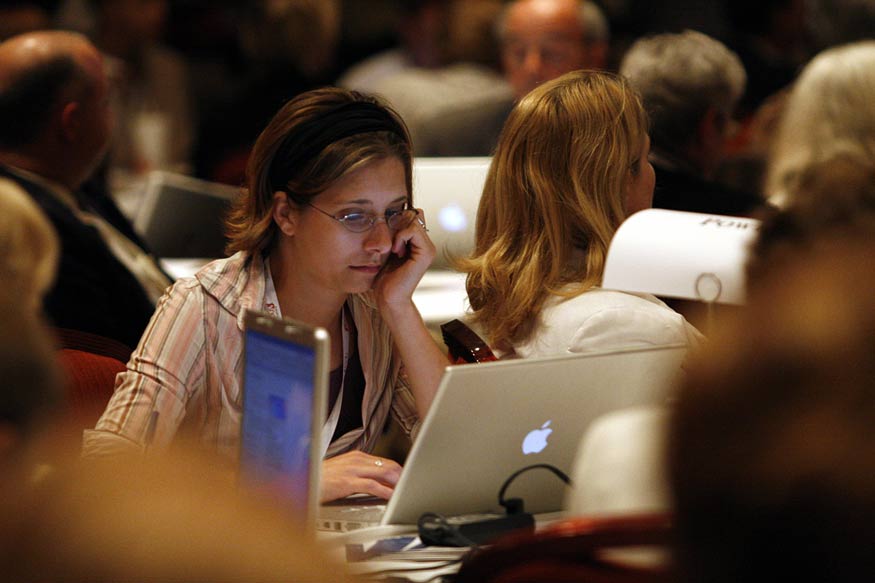
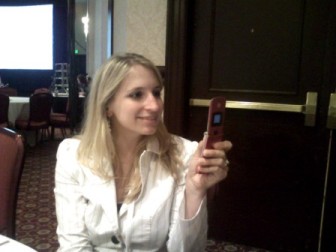
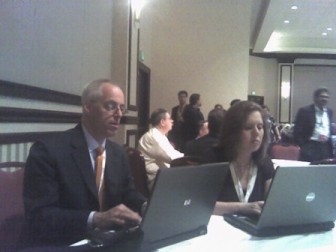
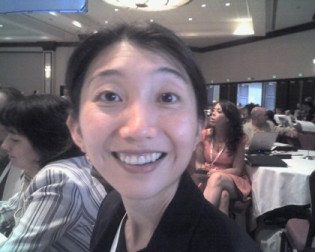

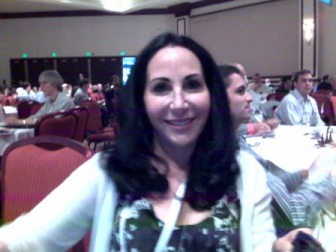
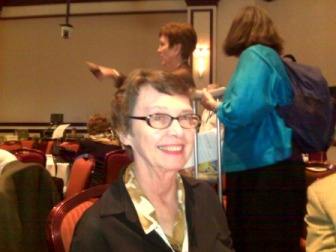
Posted by mclennan at 2:48 PM | Comments (0)
A Picture
by Douglas McLennan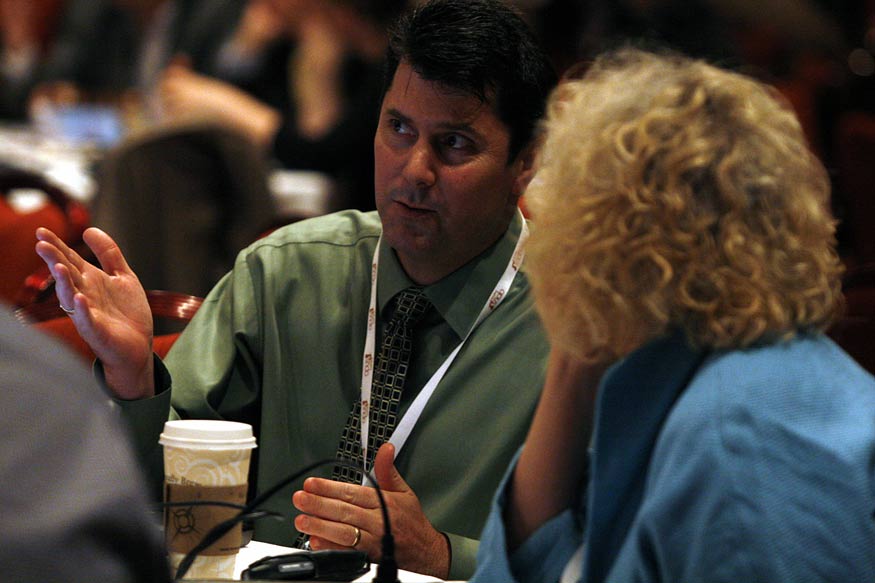
Posted by mclennan at 2:35 PM | Comments (0)
Reactions to the Book from the Field
by Molly SheridanGerard McBurney is up first. (You should read this part of the post in a charming British accent for full effect--adds impact, let me tell you.)
McBurney brings his dual-coast experience abroad and at the Chicago Symphony to this discussion. He is struck by the traditional arts audience member's unfortunate instinct to only look for two traditional key characteristics at a classical concert: it should be familiar and uplifting. He also draws attention the importance placed on performers over pieces. These are the points we focus on when discussing the art, so that's how we listen: in comparison. McBurney's professional focus is on exploring what the composer meant, and he urges us to focus on the interplay between the composition and the performance.
In the book, McBurney takes issue with the use of the word "consumption" when talking about art: paying for something does not mean you eat it. The audience member must be a participant, but only in the sense that he or she is an extremely active (i.e. alert) listener. Live performance is not a relaxing massage.
Clive Gillinson, executive and artistic director, Carnegie Hall (and also British), agrees with the authors that the challenges are huge and it's a very exciting time of change, but when you stand back it requires an act of faith that this extraordinary art will continue to matter to people, even if the economic model is not clear right now.
But he has some concerns. The book is focused on America, missing the broader picture/world. He also finds the scope of the book too wide in terms of the art forms it explores (i.e. not just the complex ones like the orchestral world), and that might lead to some false conclusions. He also cautions against drawing direct parallels with other arts institutions. We are not an art gallery. But we also don't have to become a cathdral. We can go on about concert dress and such, but who has walked out of a great concert and said they loved it but wished the musicians had been wearing different clothes.
When it comes to concerns about 21st-century audience engagement, we do need devote resources to education, and we need to ensure that there aren't barriers to access. There's no problem if they don't want to come, but we have to have given them the chance. Increased creativity (witnessed online) is great, but this so-called creativity prevalent in culture right now can be an avalanche. Good for people, but much of it is boring to a wider general audience.
Infinite choice is just as difficult as no choice at all. The role that communities play in selection is very important in helping people not waste time and highlights the fact that we're all desperately going to need people who can help up, show us where to look across this wealth of content.
Brent Assink, executive director, San Francisco Symphony (and not British), gets an early cheer from the crowd when he announces that people love live orchestra performances. His comments this afternoon focused on how right the orchestra concert experience is as it is based on the great concerts he has witnessed. His position is that we need to keep audience in the dark literally, but not figuratively. People come to the halls even though they could stay home and hear it on CD. They spend a lot of money and time to come to shows. Something more is at work not fully addressed in the essays. Audiences dictate not only what they are going to hear but how it will be played. The exchange of energy between the stage and the audiences makes that possible. Pre- and post-concert talks and program notes help support that situation. Education broadens the experience and allows them to be better participants. They don't want to co-author, he argues. Audeinces are looking for expert guidance.
Vanessa's chapter inspires him that future generations of creative people will become very enthusiastic audiences in our concert halls. More than any group, we should be encouraging the young people who play musical instruments, encourage them to write for orchestras and chamber ensembles. More than any factor, this is the most siginificant indication of future attendance.
At the end of the day, he says, this is all a mystery. It's not about the analysis and research in the end. We are in a wonderful position, let's focus on doing what we do with renewed vigor and enthusiasm.
Here are your questions:
- How would you define success for your organization ten years from now, what would it look like?
- What one action do you intend to take when you get home?
- What big, unanswered questions remain for you?
Now, talk amongst yourselves. I need some coffee.
Posted by msheridan at 2:28 PM | Comments (2)
Say What?
by Molly SheridanWe're taking a short break for real world necessities. Wow, the kids are really typing in this room, as well as globally. Check out the comments if you haven't yet.
Posted by msheridan at 1:43 PM | Comments (0)
3:30 p.m.
by Molly SheridanSteve Tepper is up to talk about how young people use technology to discover art that is important to them. Is the technology we're using today just a fad, here for good, or will there be a hybrid form that evolves out of it?
Tepper walks us through a history of technology and the arts since the phonograph. Whew, what timeline.
Today technology means we face unlimited choice. 20 million available tracks, 7 million blogs (blogs talking about those 20 million tracks?). This allows an amazing range of grazing. Tepper's research focuses on how college students are using technology. His stats: most listen to 15 different artists a week, almost half actively looking for new things to try. Social networks and MSM still mean a lot more (80% vs 40%) than technology--radio station listening and friends vs P2P. But there are fewer mavens--i.e. the people we look to to recommend music in our communities--active in the "classical" genre" as compared with other genres. Mavens are more important than the technology. Technology is a tool, not a driving behavior.
How can orchestras position themselves in this social networking world? This is the path to getting into young people's communities. Search through playlists on services like Rhapsody to find them.
When we discover something new, we like to share. People are looking for new things, but they want it to have social currency they can share with each other. The challenge is figuring out how we can do that.
Tepper had lots of great slides and talked very fast. I know I missed a lot of great content. Sorry. Please check out his chapter in the book if it catches your interest.
Posted by msheridan at 1:33 PM | Comments (0)
3:10 p.m.
by Molly SheridanLynne Conner is up next talking about early reactions to Waiting for Godot. Middle class audiences didn't get it, by and large, but another audience made up of a crowd of prisoners at San Quentin got it, and boy did they, motivated to analyze the work and actively engage with its subject matter.
Audiences historically have been much more involved in performances--to the point of sitting on the stage or making a performer repeat part of a performance they particularly liked. While we're being asked to welcome new levels of audience participation, this is not new and doesn't need to be feared--old audiences were not obscene or misbehaved. But arts organizations, led by orchestras it turns out, started this sacralization of the arts and correct audience behavior. Audiences have lost the opportunity to co-author the performance event, an opportunity sports fans have, which helps them analyze and enjoy the experience. Why not re-democratize the arts experience in this same way? People who can't talk and explore for themselves feel disengaged. People don't want art, but the arts experience.
The crowd is now back to pondering. Same questions as posted below.
Posted by msheridan at 1:10 PM | Comments (2)
Discussion Time
by Laura JacksonCan we have more discussion time? We only have time for brief comments.
LJ
Posted by ljackson at 12:52 PM | Comments (1)
2:50 p.m.
by Molly SheridanVanessa Bertozzi, who has been participating all along in this AJ blog, is up first and has some great photos of Chloe and the cosplay folks she talks about in her chapter in the book. Check in with her website to catch up on her work and take a look yourself.
The focus of her comments comes to a simple point that these new active cultures common among today's artistic young people represent a great community of enthusiastic arts participants, but they want to know all the background and participate with the artists. Her conclusion as it applies to orchestras is that the music is great; there's no problem there. New ways for the audience to participate alongside will not only be inspiring, they'll possibly be fundamental.
Questions to ponder here in the room and at home:
- How is this concept different from the world you know?
- In what ways do these forms of engagement represent opportunities and/or challenges for orchestras?
Posted by msheridan at 12:41 PM | Comments (0)
A Grainy Picture of Molly Blogging
by Douglas McLennanPosted by mclennan at 12:41 PM | Comments (0)
Another Picture
by Douglas McLennan
Posted by mclennan at 12:33 PM | Comments (0)
The Difficulties of Choice
by Douglas McLennanBill Ivey is talking about challenges in the ways people are approaching cultural institutions. There's the audience we know, he says, and they're getting older. But culture flows freely and we have to expand our definitions of culture. Clearly this is a challenge for traditional arts groups. Not just because of competition, but in the ways arts organizations need to think about how they interact with their audiences. How do you preserve the integrity of your traditional product but expand to meet new needs?
Posted by mclennan at 12:25 PM | Comments (0)
Pictures
by Douglas McLennan
Posted by mclennan at 12:13 PM | Comments (1)
2:30 p.m.
by Molly SheridanJesse Rosen, executive vice president and managing director of the ASOL, welcomes the group with a perspective-setting anecdote about his son, who first asked for an iPod when he was just two years old. The message: Change is coming. Rosen points out that there's no "right" answer, however, and the role the League it taking is to get us all together to share ideas--both here in the room and with those of you reading online--for just this purpose.
Next up to the podium is Daniel Windham, director, arts programs, at The Wallace Foundation. That foundation is dedicated to making sure the arts belong to everyone, and so these types of conversations are very important to them. Where are the young people? Why are communities not participating in the arts in the same numbers that they used to? The Wallace foundation supported the book, Engaging Art, for precisely this reason.
Bill Ivey, director of the Curb Center for Art (among many other accolades) and co-editor of that book, welcomes us and notes the history of how Americans once experienced art--home pianos and drawing for pleasure. When player pianos made an appearance, passive art consumption began growing, and technology only expanded this trend in the following decades. It was a new era in the arts experience--professional artist and the average person consuming it. That expanded to an industry, with structures and funding that grew along with it. Attendance, is how we judged cultural consumption.
The opening years of the 21st century suggest that a large shift is on the horizon. The upcoming audiences are going to be made art makers themselves. It's an age of unprecedented cultural choice and be looking for curators. Audiences will want to participate in what the professional organizations seek to present to them.
Molly again: If you've ever been to a conference, you've probably attended one of those panel discussions that never seems to get going or you hope to make a comment or ask a question, only to have the moderator never get to you. Here, the crowd is already typing and getting ready to jump in.
Posted by msheridan at 12:10 PM | Comments (0)
This Is an Experiment
by Molly SheridanThis ballroom is cavernous, so it's going to be a test of the technology and the guest speakers to see how well we do on this whole "engagement" concept, I think. There are screens set up behind the speakers on stage and then a few more hanging from the ceiling midway down the room. They each display a different comment and will be constantly changing as the event progresses. Right now we've got a mix of pullquotes from the AJ blog this week and comments from the crowd gathered here (and the room is definitely filling up and buzzing). Everyone certainly sounds excited.
Doug McLennan kicks off the event by asking everyone to turn their cellphones on and take a picture of the room, and then email it to the blog. He'll be adding them to this page throughout the event for the viewers at home. A little virtual hello from those of us in Nashville to you at home.
Posted by msheridan at 11:54 AM | Comments (0)
Ready, Set...
by Molly SheridanSo, it's been a compelling week of chatting about the future of the performing arts in general (and the orchestra in particular) here on ArtsJournal. At times, things started to feel a bit dark, but flying out of NYC with a crowd of people (talking about orchestra music!) and then arriving Nashville (with hundreds of other orchestra fans), it was hard not to feel much more enthusiastic about things.
Now we're here in the ballroom of the Renaissance Hotel in Nashville for a 3-hour live session of Engaging Art: Research, Practice, Innovation. Though "engagement" is clearly not just about new technology, there is a heavy lean here in the room on the opportunities for audience participation that such tools allow.
Even though these are tools I work with every day in my personal and professional life, I did wonder how much this applied to the typical orchestra audience and if it was good to jump in and start using them now in audience engagement activities or if we should hang back and wait. But then I saw that Clinton campaign Sopranos spoof on CNN this morning and realized that the average American is right on the heels of the fancy technology folks; the gap is not just closing, it might have already closed. So here we go!
Posted by msheridan at 11:41 AM | Comments (1)
Join us Today
by Douglas McLennanToday we will try to take this conversation that we've been having online for the past week to a live audience. This afternoon (2-5 PM CDT) in Nashville, 600 delegrates to the American Symphony Orchestra League's annual conference will gather to hear presentations by authors of Engaging Art: The Next Great Transformation of America's Cultural Life and talk about the book's findings.
One of the things I like about these online conversations is that they're quite different from the kinds of exchanges that happen in live panels. Not better, but certainly different. So perhaps there's a way to continue this online conversation at the same time 600 of us gather in a ballroom.
What's Happening
Highlights from the past week on this blog will be projected on giant screens in the room while the audience gathers from 1:30-2. At 2 everything will go live. Molly Sheridan and I will be live-blogging right here, reporting on what's going on. You on the web are invited to submit comments or questions and we'll add them to the mix and project them on the screens (Tell us where you're writing from!). Attendees in Nashville have been asked to bring their laptops and they will have wireless access to the web. They can monitor this blog, look at the stream of comments , and file their own observations and questions to the blog.
The presenters onstage will have a monitor to see the online conversation and will be able to respond from the stage.We'll also be feeding moderator Steve Tepper a printout of questions and comments that he can draw on as the afternoon progresses.
This is obviously all a big experiment. It could be distracting for some in the room. And imagine being a speaker while behind you people in the audience are commenting on what you're saying. But it might also be an opportunity to add more layers to a discussion - a kind of "live hypertext", where those participating have an opportunity to follow their own ways through the event.
The bottom line is that if our topic is how audiences are changing the ways in which they engage in the arts, then maybe it's worth seeing if we can engage ourselves in a different way.
So please participate! Here's your opportunity to speak directly to the leaders of America's symphony orchestras and to see what others in the orchestra world are thinking. Click the "comments" link on this page between now and 5 PM CDT today and be heard!
Posted by mclennan at 6:09 AM | Comments (3)


